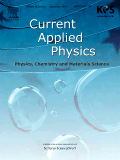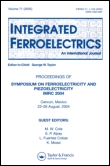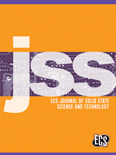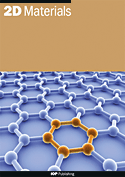
Journal of Ovonic Research
Scope & Guideline
Exploring Innovative Pathways in Electronics and Optics.
Introduction
Aims and Scopes
- Optoelectronic Materials and Devices:
Research on materials such as perovskites, nanocomposites, and thin films that are critical for optoelectronic applications, including solar cells, photodetectors, and light-emitting devices. - Energy Conversion Technologies:
Exploration of advanced materials and devices for energy generation and storage, including solar cells, supercapacitors, and batteries, focusing on efficiency improvements and novel material compositions. - Nanostructured Materials:
Synthesis and characterization of nanomaterials, including metal oxides, nanocomposites, and quantum dots, and their applications in various fields such as catalysis, sensing, and energy storage. - Theoretical and Computational Studies:
Utilization of first-principles calculations and simulations to predict material properties and guide experimental research, enhancing the understanding of material behavior at the atomic level. - Characterization Techniques:
Application of various characterization techniques, including spectroscopy, microscopy, and electrical measurements, to study the structural, optical, and electrical properties of materials.
Trending and Emerging
- Perovskite Solar Cells:
Research on perovskite materials for solar cells is rapidly increasing, focusing on improving efficiency, stability, and scalability, reflecting the growing importance of these materials in renewable energy technology. - Nanocomposites for Energy Applications:
There is a rising trend in the synthesis and application of nanocomposites, particularly for energy storage and conversion, showcasing their potential to enhance performance in supercapacitors and batteries. - Computational Material Science:
An increasing number of studies utilize computational methods, such as density functional theory (DFT), to predict and optimize material properties, indicating a shift towards data-driven research. - Sustainable and Green Materials:
A growing interest in the development of sustainable materials and processes, including biodegradable and environmentally friendly alternatives, is emerging, aligning with global sustainability goals. - Advanced Characterization Techniques:
Emerging trends in advanced characterization methods, including in-situ techniques and synchrotron-based studies, indicate a focus on gaining deeper insights into material behavior under operational conditions.
Declining or Waning
- Traditional Bulk Materials:
There is a noticeable decrease in research focused on conventional bulk materials as interest shifts towards nanostructured and hybrid materials, which offer enhanced properties and functionalities. - Low-Efficiency Solar Cell Designs:
Research on older, less efficient solar cell designs is less prevalent, as the focus moves towards high-efficiency perovskite and tandem solar cell technologies. - Classical Characterization Methods:
The reliance on classical methods for material characterization is waning, with more emphasis on advanced techniques and computational methods to provide deeper insights into material properties.
Similar Journals

ADVANCED FUNCTIONAL MATERIALS
Unleashing the Potential of Cutting-edge Materials ResearchADVANCED FUNCTIONAL MATERIALS is a leading journal published by WILEY-V C H VERLAG GMBH, prominently recognized in the fields of biomaterials, chemistry, condensed matter physics, and materials science. With an impressive impact factor and a distinguished position in the Q1 quartile across multiple categories including nanoscience and nanotechnology, this journal serves as a vital platform for researchers and professionals committed to innovating in functional materials. Since its inception in 2000, ADVANCED FUNCTIONAL MATERIALS has published high-quality peer-reviewed articles that push the boundaries of materials science, exploring new frontiers in electronic, optical, and magnetic materials. The journal's dedication to open access ensures that its groundbreaking findings are readily available to a global audience, fostering collaboration and knowledge-sharing among scholars and practitioners in the field. For those seeking to stay at the forefront of materials research, ADVANCED FUNCTIONAL MATERIALS is an essential resource.

CURRENT APPLIED PHYSICS
Pioneering Research for Practical Applications.Current Applied Physics is a leading journal published by Elsevier, specializing in the dynamic fields of Physics and Materials Science. With an ISSN of 1567-1739 and an E-ISSN of 1878-1675, this journal focuses on the latest advancements and applications of physics principles in various practical domains. Operating from the innovative hub of Amsterdam, Netherlands, Current Applied Physics occupies a significant niche in the scientific community, evidenced by its Q2 ranking in both the Physics and Astronomy and Materials Science categories for the year 2023, along with impressive Scopus rankings that highlight its relevance in the fields of General Physics and General Materials Science. The journal's scope encompasses a wide range of topics, fostering interdisciplinary collaboration and facilitating the exchange of knowledge among researchers, professionals, and students. Each issue features peer-reviewed articles that contribute to the understanding and application of physical sciences, making it an essential resource for those aiming to stay at the forefront of research and innovation in applied physics.

Crystals
Exploring the Boundaries of Crystalline InnovationCrystals is a premier open-access journal, published by MDPI since 2011, that focuses on the multidisciplinary fields of chemical engineering, condensed matter physics, inorganic chemistry, and materials science. With its E-ISSN 2073-4352, the journal is headquartered in Switzerland, and actively contributes to the global scientific community by facilitating the dissemination of high-quality research. Ranking in the Q2 quartile across multiple categories, including Chemical Engineering (miscellaneous) and Materials Science (miscellaneous) for 2023, Crystals provides a platform for innovative studies that span from fundamental research to practical applications. The journal's commitment to open access ensures that groundbreaking findings are readily available to researchers, professionals, and students alike, fostering an environment of collaboration and knowledge sharing that is essential in advancing the scientific understanding of crystalline materials.

INTEGRATED FERROELECTRICS
Unlocking the Potential of Ferroelectric MaterialsINTEGRATED FERROELECTRICS is a prominent academic journal published by Taylor & Francis Ltd, focusing on the interdisciplinary study of ferroelectric materials and their applications. Since its inception in 1992, it has provided a platform for high-quality research and innovative findings within fields such as ceramics and composites, condensed matter physics, and electrical engineering. Despite currently holding a Q4 quartile ranking across several categories—including Ceramics and Composites and Electrical and Electronic Engineering—the journal plays a crucial role in disseminating knowledge and fostering collaboration among scientists and engineers dedicated to advancing ferroelectric technology. With an increasing emphasis on the practical applications of electronic and optical materials, INTEGRATED FERROELECTRICS offers valuable insights for researchers, providing them with a repository of knowledge that is essential for both academic exploration and practical implementation.

JOURNAL OF ELECTRONIC MATERIALS
Exploring Innovations in Materials Science Since 1972Welcome to the Journal of Electronic Materials, a premier publication in the field of materials science. Published by Springer, this esteemed journal has been a beacon for groundbreaking research in electronic, optical, and magnetic materials since its inception in 1972. As an established resource, it boasts a commendable impact factor and categorically ranks in the second quartile (Q2) in key areas such as Condensed Matter Physics and Electrical and Electronic Engineering, as well as holding a respectable third quartile ranking in fields related to Electronic, Optical, and Magnetic Materials and Materials Chemistry. Researchers, professionals, and students can access a wealth of knowledge as we publish original articles, reviews, and cutting-edge research that push the boundaries of science and technology in these critical fields. Stay informed and engaged as we explore advancements that shape the future of electronic materials.

ECS Journal of Solid State Science and Technology
Advancing the Frontiers of Solid State ResearchECS Journal of Solid State Science and Technology, published by the Electrochemical Society, is a prominent journal dedicated to the advancement of research in the field of electronic, optical, and magnetic materials. With an ISSN of 2162-8769 and an E-ISSN of 2162-8777, this journal has established a significant presence since its inception in 2012, spanning critical developments in solid-state science that are essential for innovative technologies. Operating within the United States and recognized for its global outreach, it holds a respectable Q3 category ranking in the materials science category as of 2023, reflecting its commitment to high-quality research and its role in bridging theoretical and applied aspects of materials science. Researchers, professionals, and students alike will find vital information and cutting-edge studies that further the understanding and applications of solid-state technologies. The journal is accessible to an extensive audience, making it an invaluable resource for those engaged in the ever-evolving landscape of materials science.

2D Materials
Leading the Charge in 2D Materials Innovation2D Materials is a leading peer-reviewed academic journal published by IOP Publishing Ltd, dedicated to advancing the field of two-dimensional (2D) materials research. Since its inception in 2014, the journal has rapidly become a primary platform for disseminating cutting-edge findings across a broad spectrum of disciplines, including Chemistry, Condensed Matter Physics, Materials Science, and Mechanical Engineering, successfully securing a top-tier quartile ranking (Q1) in these fields as of 2023. With an impressive Scopus ranking—placing it in the top 7% in Mechanical Engineering and top 8% in Condensed Matter Physics—this journal exemplifies excellence in scholarly communication. The journal offers diverse access options to cater to a global audience, underscoring its commitment to fostering collaboration and innovation within the scientific community. As researchers, professionals, and students continue to explore the vast potential of 2D materials, 2D Materials remains at the forefront, shaping the future of material science with impactful research and comprehensive reviews.

PHYSICA STATUS SOLIDI B-BASIC SOLID STATE PHYSICS
Advancing Knowledge in Condensed Matter SciencePHYSICA STATUS SOLIDI B-BASIC SOLID STATE PHYSICS, published by Wiley-VCH Verlag GmbH in Germany, is an esteemed journal within the condensed matter physics sphere, covering pivotal advancements in basic solid state physics. With a rich history dating back to 1961, it serves as a scholarly platform for researchers, professionals, and students alike, providing insights into the fundamental properties and applications of electronic, optical, and magnetic materials. The journal currently holds a respectable Q3 ranking in both Condensed Matter Physics and Electronic, Optical, and Magnetic Materials as of 2023, indicating its impactful contributions to these fields despite its competitive landscape. While it does not offer open access, its comprehensive research findings are critical for those engaged in innovative material science research. With a convergence period extending to 2024, PHYSICA STATUS SOLIDI B continues to play a significant role in facilitating knowledge exchange and fostering advancements in solid state physics.

Materials Chemistry Frontiers
Elevating Knowledge in the World of Materials ChemistryMaterials Chemistry Frontiers, published by the esteemed Royal Society of Chemistry, stands as a leading journal in the realm of materials science and chemistry, with an impressive Q1 ranking in both Materials Chemistry and Materials Science categories as of 2023. This open-access journal, operating from the United Kingdom, offers a platform for researchers, professionals, and students to disseminate high-quality, impactful research. With its E-ISSN 2052-1537, the journal is dedicated to publishing cutting-edge articles, reviews, and research communications that explore innovative materials and their applications, fostering a comprehensive understanding of the complex interplay between materials and their chemical properties. With consistent rankings in the Scopus metrics, being positioned at the 25th percentile among 317 in the Materials Chemistry category, it highlights its pivotal role in advancing the field. The journal thrives on contributions that broaden the scope of knowledge from 2017 to 2024 and beyond, solidifying its status as an essential resource for contemporary research in materials science.

Nano Futures
Empowering Researchers with Open Access to Nano DiscoveriesNano Futures, published by IOP Publishing Ltd, is an influential journal dedicated to advancing the field of nanoscale science and technology, encompassing a wide range of disciplines such as Atomic and Molecular Physics, Bioengineering, and Materials Science. With a growing impact within the academic community, this journal has achieved a notable Q2 classification in categories like Chemistry and Electrical Engineering, making it a critical resource for researchers, professionals, and students seeking to explore innovative advancements in nanotechnology. Established in 2017 and operating through 2024, Nano Futures provides open access options for readers, ensuring wider dissemination and engagement with cutting-edge research findings. The journal's commitment to showcasing high-quality research makes it an essential channel for exploring the intersection of nanoscale innovations and practical applications in various industries.